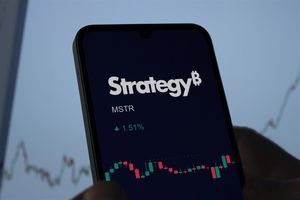
The semiconductor industry, the very bedrock of the artificial intelligence (AI) revolution, is no stranger to volatility. However, recent significant moves by major institutional investors have sent palpable ripples through the market, illustrating just how sensitive chip stock performance and overall market dynamics are to these high-stakes decisions. A prime example of this occurred in late 2025, when SoftBank Group (TYO: 9984) divested its entire stake in Nvidia (NASDAQ: NVDA), a move that, while strategic for SoftBank, immediately impacted market sentiment and underscored underlying concerns about AI valuations. This event, occurring in October/November 2025, highlighted the intricate dance between investor confidence, technological advancement, and the inherent cyclicality of the chip sector.
This article decodes the intricate dynamics of semiconductor stock volatility, particularly focusing on the profound influence of large investor decisions. It examines how substantial sales by entities like SoftBank can reshape the competitive landscape, accelerate technological trends, and introduce both opportunities and risks across the burgeoning AI ecosystem. As of November 11, 2025, the market continues to digest such shifts, keenly watching for signs of sustained growth or impending corrections in this pivotal industry.
The Nvidia Earthquake: Decoding SoftBank's Strategic Pivot
SoftBank Group's (TYO: 9984) decision to sell its entire holding in Nvidia (NASDAQ: NVDA) for approximately $5.8 billion in October 2025 was a defining moment, sending a noticeable tremor through the global tech market. The sale involved 32.1 million Nvidia shares and was not, as SoftBank clarified, an indictment of Nvidia's long-term prospects. Instead, it represented a calculated strategic pivot by CEO Masayoshi Son to reallocate substantial capital towards direct, hands-on investments in AI and semiconductor ventures. This includes ambitious projects like the $500 billion "Stargate" initiative, a joint venture with Oracle (NYSE: ORCL), OpenAI, and Abu Dhabi's MGX, aimed at building a global network of AI data centers. Furthermore, SoftBank has pledged significant funding to OpenAI, reportedly up to $40 billion, and invested $2 billion in Intel (NASDAQ: INTC), acquiring approximately a 2% ownership. This strategic realignment signifies SoftBank's intent to industrialize AI by controlling both the silicon (through its majority ownership of Arm (NASDAQ: ARM)) and the systems that power it.
The immediate market reaction to SoftBank's announcement was swift. Nvidia's stock experienced a dip of around 2% to 3.5% at the start of U.S. trading following the disclosure. While Nvidia's shares remained near all-time highs due to robust earnings and strong forward guidance, the dip highlighted investor sensitivity to large institutional moves. Beyond Nvidia, the news sent ripples across the broader tech sector, with other tech giants and the Nasdaq Composite index also experiencing declines. This reaction underscored investor concerns about potentially stretched valuations in AI-related semiconductor stocks, leading to a "risk-off" sentiment in early November 2025 that temporarily erased billions in market value globally.
Technically, the sale, likely executed as a block trade to minimize market disruption, demonstrated the profound impact of supply-demand imbalances, even when managed privately. Despite the fundamental strength of Nvidia's Blackwell architecture and H200/B200 Tensor Core GPUs, which remain in "insatiable" demand from hyperscale cloud providers and enterprise AI labs, the psychological impact of such a large divestment by a prominent investor cannot be overstated. It prompted a re-evaluation of where future value might accrue within the rapidly evolving technology sector, especially considering the ongoing "silicon supercycle" driven by AI and the increasing demand for advanced manufacturing nodes and High Bandwidth Memory (HBM).
Reshaping the AI Battleground: Corporate Implications
SoftBank's strategic pivot and similar large investor moves have profound implications for AI companies, tech giants, and startups, reshaping the competitive landscape and strategic advantages across the industry. While Nvidia (NASDAQ: NVDA) experienced an immediate stock dip from the SoftBank sale, its fundamental position as a "cornerstone of the AI revolution" remains robust due to its cutting-edge GPUs and an unparalleled software ecosystem like CUDA, which fosters strong developer lock-in. However, the event highlighted the increasing pressure on Nvidia to maintain its dominance as competitors and major tech giants intensify their efforts.
Companies like Advanced Micro Devices (NASDAQ: AMD) and Intel (NASDAQ: INTC) stand to benefit from any perceived market opening or investor diversification. AMD is aggressively challenging Nvidia with its MI300 series, aiming to capture a larger share of the AI chip market, including a significant multiyear partnership with OpenAI. Intel, bolstered by SoftBank's $2 billion investment, is also pushing its Gaudi3 AI accelerators. This intensified hardware competition promises more viable alternatives for AI labs and tech companies, potentially diversifying the hardware landscape.
For AI startups, SoftBank's direct investments in AI infrastructure and ventures like the Stargate project could channel significant capital into promising new companies, particularly those aligned with specific AI hardware and software innovations. Startups developing more cost-effective or energy-efficient inference solutions could gain traction as alternatives to Nvidia's often expensive hardware. Conversely, a momentary "AI bubble" sentiment following a high-profile sale could lead to increased scrutiny and tighter funding conditions for some AI ventures. Tech giants such as Amazon Web Services (AWS), Google Cloud (NASDAQ: GOOGL), and Microsoft Azure (NASDAQ: MSFT) are already developing their own custom AI chips (e.g., Google's Tensor Processing Units or TPUs, AWS's Trainium) to reduce dependency on external suppliers and optimize for their specific AI workloads, a trend that will only accelerate with continued market volatility and strategic reallocations.
The overarching trend is an accelerated push towards strategic partnerships and vertical integration within the AI ecosystem. Chipmakers are forging long-term alliances with leading AI firms, and tech giants are increasingly integrating chip design into their operations. This not only reduces reliance on a single vendor but also allows for greater optimization of hardware and software for specific AI applications. Increased investment and competition in the semiconductor sector will drive rapid innovation in hardware performance and energy efficiency, leading to the development of more powerful AI models and potentially democratizing access to advanced AI computing by making it cheaper and more widely available in the long term.
A Wider Lens: AI's Silicon Supercycle and Geopolitical Chessboard
The semiconductor market's volatility, exemplified by SoftBank's (TYO: 9984) Nvidia (NASDAQ: NVDA) sale, fits into a broader narrative of an "AI Supercycle" and a complex geopolitical chessboard. The AI industry is experiencing a "historic acceleration," with demand for AI infrastructure and computing power driving monumental growth in the global semiconductor market. The compute segment, encompassing CPUs, GPUs, and specialized AI accelerators, is projected for robust growth, underscoring a fundamental shift driven by AI workloads across cloud, edge, and on-premises deployments. This period is characterized by a sustained surge in demand for specialized AI accelerators, high-bandwidth memory (HBM), and advanced networking components, with AI expected to drive nearly half of the semiconductor industry's capital expenditure by 2030.
However, this rapid ascent has ignited concerns about market stability and concentration, leading to warnings of a potential "AI bubble." The apprehension is fueled by "extreme price-to-earnings ratios" for some AI companies, high revenue-loss ratios for leading AI platforms, and a heavy reliance on "speculative future growth projections rather than current profitability." A significant concern is the "unprecedented market concentration" within a limited number of AI companies, particularly exemplified by Nvidia's immense market capitalization, which briefly crested $5 trillion in November 2025. Such concentration creates "systemic risks," as any substantial correction in a dominant stock could trigger widespread ripple effects across the broader market, as seen with Nvidia's $800 billion market capitalization loss over a few days in early November 2025, contributing to a "risk-off" sentiment.
Comparisons to the dot-com bubble of the late 1990s are frequent, citing similar characteristics like "extreme valuations based on future potential rather than current performance" and widespread investor speculation. Yet, proponents argue that today's AI technologies demonstrate "actual functional capabilities and measurable benefits in specific workflows," unlike some abstract promises of the past. Nonetheless, the rapid ascent of AI, much like the rise of the web, is fundamentally reshaping industries and driving significant economic growth and investment, albeit with increasing scrutiny from regulatory bodies regarding potential systemic risks and market concentration.
Geopolitical factors also exert a profound influence on the semiconductor market and the AI industry. Intense competition, particularly between the United States and China, has led to "export controls, supply chain restrictions, and significant investment in domestic semiconductor production," reflecting a global shift towards "technological sovereignty and security." US restrictions aim to hinder China's development of advanced chips crucial for military and AI applications, influencing sales for companies like Nvidia. In response, China has escalated tensions by banning the export of critical rare minerals vital for semiconductor manufacturing. The geographic concentration of advanced chip manufacturing, with over 90% of the world's most advanced chips produced in Taiwan and South Korea, creates significant vulnerabilities and makes the supply chain a "focal point of both innovation and strategic rivalry," directly contributing to market volatility and shaping companies' strategic decisions.
The Horizon: Future Developments in AI and Silicon
Looking ahead, the semiconductor industry and the AI landscape are poised for continuous, rapid evolution, driven by an insatiable demand for AI-specific hardware and strategic shifts by major investors. In the near term, leading up to and including November 2025, the focus remains on advancing manufacturing nodes, with mass production of 2nm technology anticipated to commence. High Bandwidth Memory (HBM) is experiencing an aggressive ramp-up, with HBM4 expected in the second half of 2025, becoming a core piece of AI infrastructure despite persistent supply tightness. Major tech companies are also intensifying their efforts to develop custom AI silicon (ASICs), like Google's (NASDAQ: GOOGL) seventh-generation TPU "Ironwood" and Meta's (NASDAQ: META) MTIA chip, to reduce reliance on general-purpose GPUs and optimize for specific AI workloads. The "kick-off" for AI PCs is also expected in 2025, with AI-enabled laptops projected to account for over 50% of global PC shipments within a few years, transforming personal computing.
Longer term, the evolution of AI chips will focus on more fundamental architectural changes to meet escalating computational demands and improve efficiency. This includes further advancements in memory technologies towards HBM5/HBM5E by the end of the decade, heterogeneous computing combining various processor types, and sophisticated 3D chip stacking and advanced packaging techniques to improve data transfer and reduce energy consumption. Emerging technologies like silicon photonics, which uses light for data transmission, promise ultra-high speeds and lower latency. Neuromorphic computing, modeled after the human brain, aims for unparalleled energy efficiency, potentially revolutionizing AI at the edge. By 2030, a significant portion of generative AI compute demand is expected to shift to inference workloads, favoring specialized, energy-efficient hardware like ASICs.
These advancements will unlock a vast array of new applications and use cases. AI will increasingly optimize semiconductor manufacturing itself, improving chip design workflows and enabling smart factories with predictive maintenance. Generative AI and "Agentic AI" applications will see exponential growth in complex conversational AI and integrated multimedia content creation. The longer horizon points to "Physical AI," encompassing autonomous robots, humanoids, and industrial systems, requiring purpose-built chipsets. Edge AI will expand to IoT devices, enabling local data processing with minimal power consumption, enhancing privacy and real-time capabilities across industries from healthcare to finance.
However, significant challenges loom. Supply chain vulnerabilities persist due to raw material shortages, geopolitical conflicts (particularly US-China trade tensions), and a heavy dependence on a few key manufacturers. Energy consumption remains a critical concern, with data centers' electricity use projected to double by 2030, necessitating more energy-efficient hardware and renewable energy solutions. Ethical concerns surrounding AI, including bias in algorithms, lack of human oversight, privacy and security, environmental impact, and workforce displacement, also need proactive addressing through robust ethical guidelines, transparency, and sustainable practices. Experts predict a robust semiconductor market, largely driven by AI, with global revenue expected to reach approximately $697 billion in 2025 and surpass $1 trillion by 2030. Despite high valuations, market analysts remain generally bullish on AI and semiconductor stocks but advise diversification and close monitoring of manufacturing ramp-ups to mitigate risks associated with market volatility and potential overvaluation.
The AI Chip Odyssey: A Concluding Assessment
The semiconductor industry, currently experiencing an unprecedented "AI Supercycle," is at the heart of a technological transformation comparable to the dawn of the internet. SoftBank's (TYO: 9984) strategic divestment of its Nvidia (NASDAQ: NVDA) stake in late 2025 serves as a potent reminder of the profound impact large investor moves can have on market dynamics, individual stock performance, and the broader sentiment surrounding the AI industry. While the immediate market reaction was a dip and a "risk-off" sentiment, SoftBank's pivot towards direct investments in AI infrastructure, like the Stargate project, and key players such as OpenAI and Intel (NASDAQ: INTC), signals a deeper confidence in AI's long-term trajectory, albeit with a re-evaluation of how best to capitalize on it.
This development underscores several key takeaways. Firstly, semiconductor stock volatility is a multifaceted phenomenon, influenced by cyclical market dynamics, rapid technological advancements, and geopolitical pressures. Secondly, large institutional investors wield significant power, capable of triggering immediate price movements and shifting broader market sentiment through their substantial transactions. Thirdly, the AI industry is experiencing a "historic acceleration" driven by an insatiable demand for specialized hardware, leading to a "virtuous cycle of innovation" but also raising concerns about market concentration and potential "AI bubbles."
In the grand tapestry of AI history, this period will be remembered for the intense race to build the foundational compute infrastructure. The push for more powerful, energy-efficient, and specialized AI chips, coupled with the emergence of custom silicon from tech giants, signifies a maturing industry striving for greater control and optimization. However, challenges related to supply chain vulnerabilities, escalating energy consumption, and complex ethical considerations remain paramount and require concerted efforts from industry, academia, and governments.
In the coming weeks and months, market watchers should pay close attention to the ramp-up of 2nm technology and HBM production, the performance of custom AI chips from major cloud providers, and any further strategic realignments by large institutional investors. The ongoing geopolitical competition for technological sovereignty will continue to shape supply chains and market access, making the AI chip industry not just a driver of innovation but also a critical factor in international relations. The journey through this AI chip odyssey is far from over, promising continued innovation, strategic shifts, and dynamic market movements.
This content is intended for informational purposes only and represents analysis of current AI developments.
TokenRing AI delivers enterprise-grade solutions for multi-agent AI workflow orchestration, AI-powered development tools, and seamless remote collaboration platforms.
For more information, visit https://www.tokenring.ai/.







